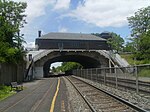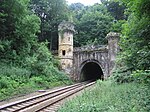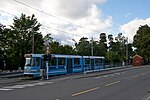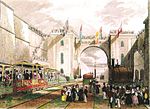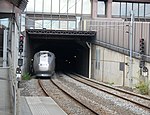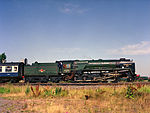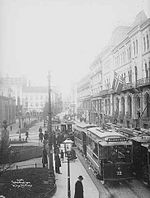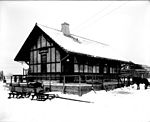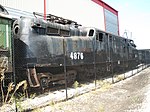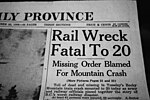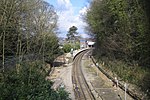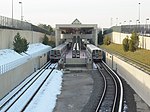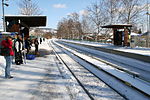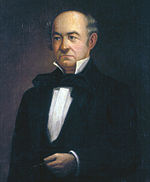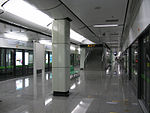Portal:Trains/Selected article/2011 archive
This is an archive of article summaries that have appeared in the Selected article section of Portal:Trains in 2011. For past archives, see the complete archive page.
- Week 52, 2010
- January 1 - January 2
The Hardanger Line (Norwegian: Hardangerbana or Hardangerbanen) was a 27.45-kilometre (17.06 mi) railway between Voss and Granvin in Hordaland, Norway. The line connected to the Bergen Line in Voss, and ran to the Hardangerfjord and the district of Hardanger. Construction started in 1921, but the line did not open until 1 April 1935. Owned and operated by the Norwegian State Railways (NSB), the passenger transport was provided by three NSB Class 64 electric multiple units. They remained in use until 1985, when passenger transport was terminated. All transport ceased in 1988, and 21 kilometres (13 mi) of the line was demolished in 1991. The 3 kilometres (2 mi) from Voss to Palmafoss remains, and is owned by the Norwegian National Rail Administration. The line featured six stations, fourteen halts, four tunnels and was among Norway's steepest railways. It was NSB's first line to open electrified. The line was known as the Granvin Line (Granvinbanen) until February 1936.
Recently selected: Quainton Road railway station - AnsaldoBreda Driverless Metro - Milwaukee Airport Railroad Station
- Week 1
- January 3 - January 9
Kingsland Station is a railroad station on New Jersey Transit's Main Line. It is located under Ridge Road (New Jersey Route 17) between New York and Valley Brook Avenues in Lyndhurst, New Jersey, United States, and is one of two stations in Lyndhurst. The station is not staffed, and passengers use ticket vending machines (TVMs) which are located at street level to purchase tickets. The station is not handicapped-accessible. Originally part of the Delaware, Lackawanna and Western Railroad's Boonton Branch, Kingsland station was built in 1903. The design of the station depot located above the tracks was later replicated by the Delaware, Lackawanna and Western's Montclair Branch for its Watsessing Avenue station in Bloomfield, New Jersey.
Recently selected: Hardanger Line - Quainton Road railway station - AnsaldoBreda Driverless Metro
- Week 2
- January 10 - January 16
Iore, often stylized IORE, is a class of 26 electric locomotives built by Bombardier Transportation for the Swedish mining company LKAB's railway division Malmtrafik. A variation of Bombardier's TRAXX line, they haul iron ore freight trains on the Iron Ore Line and Ofoten Line in Sweden and Norway, respectively. The 8,600-tonne (8,500-long-ton; 9,500-short-ton) 68-car trains are hauled by two single-ended Co′Co′ locomotives, each with a power output of 5,400 kilowatts (7,200 hp). Each operates with 600 kilonewtons (130,000 lbf) tractive effort and have a maximum speed of 80 kilometres per hour (50 mph). Delivery of the first series of 18 locomotives was made from 2000 to 2004, and they replaced some of the aging Dm3 and El 15 units. In 2007, eight more vehicles were ordered, with production to be completed by 2011.
Recently selected: Kingsland (NJT station) - Hardanger Line - Quainton Road railway station
- Week 3
- January 17 - January 23
The Bramhope Tunnel is a railway tunnel 2.138 miles (3.441 km) long, owned by Network Rail on a route currently operated mainly by Northern Rail. It was constructed during 1845–1849 on the Harrogate Line, carrying rural and commuter passengers between Horsforth and Weeton in West Yorkshire, England. It is notable for its length, for its crenellated north portal, which is Grade II listed, and for the deaths of 24 men during its construction, commemorated in Otley churchyard with a castellated replica of the north portal. It was constructed by Thomas Grainger, engineer and James Bray, overseer, who set up two sighting towers and then twenty shafts along the line of the tunnel. Men dug horizontally from these shafts until the diggings joined up in 1848. Thousands of navvies lived locally in bothies with their families, and dug in dangerous and wet conditions to facilitate the grand opening in 1849.
Recently selected: Iore - Kingsland (NJT station) - Hardanger Line
- Week 4
- January 24 - January 30
The Ekeberg Line (Norwegian: Ekebergbanen) is a 6.6-kilometer (4.1 mi) long light rail line of the Oslo Tramway which runs from Gamlebyen to Ljabru in Oslo, Norway. Operated by lines 18 and 19, it serves the area of Nordstarand and the neighborhoods of Ekeberg, Jomfrubråten, Bekkelaget and Ljan. The line is operated by Oslo Sporvognsdrift using SL79 and SL95 trams on contract with Ruter. The line itself is owned by Kollektivtransportproduksjon. At Oslo Hospital, the line connects to the Gamleby Line, which runs to the city center. Proposals for a line in the area were first launched 1897, but not until 1914 were the necessary permits granted. The line was built and operated by Ekebergbanen. The line opened in 1917, and connected to the Gamleby Line to reach Stortorvet in the city center. The line differed from the street trams in that it ran in its own right of way and used 1,200 volt supply, unlike the 600 volts used in the streets. In the early 1930s, the line was rebuilt to double track and a branch, the Simensbråten Line, was built. The Ekeberg Line was extended to its current terminus in 1941. In 1948, the company was taken over by the municipal Oslo Sporveier and operations were integrated in 1965. The line was nearly closed in 1967 and 1973, but during the 1970s, the line received new rolling stock and a renovation. Future plans include an extension to Hauketo Station on the Østfold Line and a new route via Bjørvika to the city center.
Recently selected: Bramhope Tunnel - Iore - Kingsland (NJT station)
- Week 5
- January 31 - February 6
The Tennessee Coal, Iron and Railroad Company (1852–1952), also known as TCI and the Tennessee Company, was a major American steel manufacturer with interests in coal and iron ore mining and railroad operations. Originally based entirely within Tennessee, it relocated most of its business to Alabama in the late nineteenth century. With a sizable real estate portfolio, the company owned several Birmingham satellite towns, including Ensley, Fairfield, Docena, Edgewater and Bayview. At one time the second largest steel producer in the USA, TCI was listed on the first Dow Jones Industrial Average in 1896. However, in 1907, the company was merged with its principal rival, the United States Steel Corporation. The Tennessee Coal, Iron and Railroad Company was subsequently operated as a subsidiary of U. S. Steel for 45 years until it became a division of its parent company in 1952.
Recently selected: Ekeberg Line - Bramhope Tunnel - Iore
- Week 6
- February 7 - February 13
The opening of the Liverpool and Manchester Railway (L&M) took place on 15 September 1830. Work on the L&M had begun in the 1820s, to connect the major industrial city of Manchester with the nearest deep water port at the Port of Liverpool, 35 miles (56 km) away. Arthur Wellesley, Duke of Wellington, the Prime Minister, rode on one of the eight inaugural trains, as did many other dignitaries and notable figures of the day. Huge crowds lined the track at Liverpool to watch the trains depart for Manchester. The trains left Liverpool on time and without any technical problems. The Duke of Wellington's special train ran on one track, and the other seven trains ran on an adjacent and parallel track, sometimes ahead and sometimes behind the Duke's train. At Parkside railway station, near the midpoint of the line, the locomotives made a scheduled stop to take on water. Although the railway staff had advised passengers to remain on the trains while this took place, around 50 of the dignitaries on board alighted when the Duke of Wellington's special train stopped. One of those who got off was William Huskisson, former cabinet minister and Member of Parliament for Liverpool. Huskisson approached the Duke's railway carriage and shook his hand. Distracted by the Duke, he did not notice an approaching locomotive on the adjacent track, Rocket. On realising it was approaching he panicked and fell onto the tracks in front of the train, suffering serious leg injuries and dying later that night. By the time the trains reached the outskirts of Manchester the crowd gathered there had become hostile and was spilling onto the tracks. With local authorities unable to clear the tracks, the trains were obliged to drive at low speed into the crowd, using their own momentum to push people out of the way. Eventually they arrived at Liverpool Road railway station in Manchester to be met by a hostile crowd, who waved banners and flags against the Duke and pelted him with vegetables. Wellington refused to get off the train, and ordered that the trains return to Liverpool. The death and funeral of William Huskisson caused the opening of the railway to be widely reported. The L&M became extremely successful, and within a month of its opening plans were put forward to connect Liverpool and Manchester with the other major cities of England. Within ten years, 1,775 miles (2,857 km) of railways had been built in Britain, and within 20 years of the L&M's opening over 6,200 miles (10,000 km) were in place. The L&M remains in operation, and its opening is now considered the start of the age of mechanised transport; in the words of industrialist and former British Rail chairman Peter Parker, "the world is a branch line of the pioneering Liverpool–Manchester run".
Recently selected: Tennessee Coal, Iron and Railroad Company - Ekeberg Line - Bramhope Tunnel
- Week 7
- February 14 - February 20
The Manila Purple Line (MRT-2) is the second line of the Manila Light Rail Transit System. The line contains eleven stations and runs over 13.8 kilometres (8.6 mi) of mostly elevated track, with the exception of Katipunan station, which is underground. As the name implies, the line is colored purple on all railway maps. The line runs in a general east-west direction, linking the cities of Manila, San Juan, Quezon City, Marikina and Pasig. Passengers can transfer to the Yellow Line at Recto station, while passengers can transfer to the Blue Line at Araneta Center-Cubao station. Before the launch of the Strong Republic Transit System, the Purple Line was known as MRT Line 2, shortened to MRT-2, or the Megatren. The former names are still used colloquially. However, the purple color of the line dates back to its opening in 2003. Unlike the LRT Line 1 and the MRT Line 3, this line uses heavy rail metro vehicles.
Recently selected: Opening of the Liverpool and Manchester Railway - Tennessee Coal, Iron and Railroad Company - Ekeberg Line
- Week 8
- February 21 - February 27
The Oslo Tunnel (Norwegian: Oslotunnelen) is a 3,632-meter (2.26 mi) long, double-track railway tunnel which runs between Olav Kyrres plass and Oslo Central Station (Oslo S) in Oslo, Norway. The tunnel constitutes the eastern-most section of the Drammen Line and runs below the central business district of Oslo. It features the four-track Nationaltheatret Station, Norway's second-busiest railway station, where the Oslo Tunnel lies directly beneath the Common Tunnel of the Oslo Metro. At Frogner, Elisenberg Station was built, but has never been taken into use. The tunnel is the busiest section of railway line in Norway and serves all west-bound trains from Oslo, including many services of the Oslo Commuter Rail and the Airport Express Train. Traditionally, Oslo had two stations, the larger Oslo East Station (or Oslo Ø, located at the spot of the current Oslo S) and Oslo West Station (Oslo V), which served the Drammen Line. This caused a physical barrier between the two parts of the railway network, only connected by the Oslo Port Line which ran in part in city streets. Formal planning of a central station and a tunnel connecting the Drammen Line to Oslo Ø started in 1938, and the final plans were approved in 1968. The Oslo Tunnel opened on 1 June 1980, and made it possible to close Oslo V in 1989. Nationaltheatret saw a major upgrade in 1999, when it was expanded to four tracks, and from 2008 to 2010, the tunnel will see a major technical upgrade. There are plans to build a second tunnel to increase train capacity west of Oslo.
Recently selected: Manila Purple Line - Opening of the Liverpool and Manchester Railway - Tennessee Coal, Iron and Railroad Company
- Week 9
- February 28 - March 6
The Rosendale trestle is a 940-foot (290 m) continuous truss bridge and former railroad trestle in Rosendale Village in Ulster County, New York, originally constructed by the Wallkill Valley Railroad. The bridge rises 150 feet (46 m) above Rondout Creek and Route 213, and spans the former Delaware and Hudson Canal. It was the highest span bridge in the United States when it opened to rail traffic in 1872. The bridge was rebuilt in 1895 by the King Bridge Company because of stability concerns, and it has been continually reinforced throughout its existence. The sturdiness of the trestle was a major reason Conrail closed the Wallkill Valley rail line in 1977. Conrail sold the bridge in 1986 for one dollar to a private businessman who tried unsuccessfully to operate the trestle as a bungee jumping platform in the 1990s. A similar attempt was made the following decade. After it was seized by the county in 2009, the trestle is being renovated as a pedestrian walkway for the Wallkill Valley Rail Trail.
Recently selected: Oslo Tunnel - Manila Purple Line - Opening of the Liverpool and Manchester Railway
- Week 10
- March 7 - March 13
The BR Standard Class 9F 2-10-0 is a class of steam locomotive designed for British Railways by Robert Riddles. The Class 9F was the last in a series of standardised locomotive classes designed for British Railways during the 1950s, and was intended for use on fast, heavy freight trains over long distances. It was one of the most powerful steam locomotive types ever constructed in Britain, and successfully performed its intended duties. At various times during the 1950s, the 9Fs worked passenger trains with great success, indicating the versatility of the design, sometime considered to represent the ultimate in British steam development. Several variants were constructed for experimentation purpose in an effort to reduce costs and maintenance, although these met with varying degrees of success. The total number built was 251, production being shared between Swindon (53) and Crewe Works (198). The last of the class, 92220 Evening Star, was the final steam locomotive to be built by British Railways, in 1960. Withdrawals began in 1964, with the final locomotives removed from service in 1968. Several examples have survived into the preservation era in varying states of repair, including Evening Star.
Recently selected: Rosendale trestle - Oslo Tunnel - Manila Purple Line
- Week 11
- March 14 - March 20
The Jæren Commuter Rail (Norwegian: NSB Lokaltog Jæren, previously Jærbanen) is a commuter train service operated along the western-most part of the Sørland Line in Jæren, Norway. It is operated by the Norwegian State Railways (NSB) with nine Class 72 electric multiple units. The service acts as a commuter rail connecting Stavanger to its suburbs, including Sandnes, and to towns further south, in Klepp, Time, Hå and Eigersund. Although passenger services have operated along the lines since 1878, the commuter train service was inaugurated in 1992 with a significant increase of service, using existing rolling stock. The system has an annual ridership of 2.5 million passengers to date. The service runs from Stavanger Station to Egersund Station, a distance of 75 kilometers (47 mi). It has four hourly services from Stavanger to Sandnes Station, of which two continue to Nærbø Station and one to Egersund. The section from Stavanger to Sandnes is double track, while the rest is single track. The infrastructure is owned by the Norwegian National Rail Administration and the line is also used by intercity and freight trains. Several proposed upgrades to the system have been made system, such as a branch along the Ålgård Line, a branch to Stavanger Airport, Sola and reestablishing double track from Sandnes to Egersund.
Recently selected: BR Standard Class 9F - Rosendale trestle - Oslo Tunnel
- Week 12
- March 21 - March 27
La Stazione is a restaurant and former train station in the village of New Paltz in Ulster County, New York. After a lengthy public debate over whether to place New Paltz's Wallkill Valley Railroad station to the east or west of the Wallkill River, the station was built in 1870 on the east bank, within the village. The station was robbed in 1880 by four men who were immediately arrested and brought back to the depot, where they were sent to jail by way of the railroad. The station burned down in 1907 and was rebuilt later that year. Passenger service along the line ceased in 1937, and by 1958 the station was completely closed and sold off. The building was in such a state of disrepair by the 1980s that it was almost demolished. It was renovated in 1988 and used as a real estate office. In 1999 it became an Italian restaurant, and served as the setting for a scene in a 2008 mob film. It was the first of two railroad stations constructed in the town of New Paltz, and is the only former Wallkill Valley station standing at its original location.
Recently selected: Jæren Commuter Rail - BR Standard Class 9F - Rosendale trestle
- Week 13
- March 28 - April 3
The Getå Railroad Disaster (Swedish: Järnvägsolyckan i Getå) was a train disaster caused by a landslide in Getå, a town that is now part of the municipality of Norrköping, Sweden, on 1 October 1918. The derailment occurred when the layers of colloidal clay and gravel in the embankment that had been cut into the hill gave way. Shortly afterwards, a mixed train consisting of a locomotive and ten cars came down the tracks, falling down the embankment and landing on the road below. Of the passengers and crew on board that night, 41 people were injured and at least 42 were killed or died later from injuries sustained in the crash. It is unclear how many died in the derailment compared to those who died in the blaze that followed it. Many of the passengers were burned alive as the unreinforced wooden cars caught fire, killing those who had survived the crash itself but were still trapped in the wreckage. To date, this was the worst rail accident in Swedish history.
Recently selected: La Stazione - Jæren Commuter Rail - BR Standard Class 9F
- Week 14
- April 4 - April 10
Charles Henry Holden Litt. D. FRIBA MRTPI RDI (12 May 1875–1 May 1960) was an English architect best known for designing many London Underground stations during the 1920s and 1930s, for Bristol Central Library, the Underground Electric Railways Company of London's headquarters at 55 Broadway and for the University of London's Senate House. He also created many war cemeteries in Belgium and northern France for the Imperial War Graves Commission. Although not without its critics, his architecture is widely appreciated. He was awarded the Royal Institute of British Architects' (RIBA's) Royal Gold Medal for architecture in 1936 and was appointed a Royal Designer for Industry in 1943. His station designs for London Underground became the house style influencing designs by all architects working for the organisation in the 1930s. Many of his buildings have been granted listed building status, protecting them from unapproved alteration. Modestly believing that architecture was a joint effort, he twice declined the offer of a Knighthood.
Recently selected: Getå Railroad Disaster - La Stazione - Jæren Commuter Rail
- Week 15
- April 11 - April 17
The history of the Oslo Tramway and Oslo Metro in Oslo (Kristiania until 1925), Norway, starts in 1875, when Kristiania Sporveisselskab (KSS) opened two horsecar lines through the city centre. In 1894, Kristiania Elektriske Sporvei (KES) built the first electric street tramways, which ran west from the city centre. Within six years, all tramways were electric. The city council established Kristiania Kommunale Sporveie (KKS) in 1899, which built three lines before it was sold to KSS six years later. Both KSS and KES were taken over by the municipality in 1924, becoming Oslo Sporveier. The company gradually expanded the city tram network, which reached its peak length in 1939. The Holmenkollen Line was the first light rail line, which opened in 1898 and ran west of the city. Later light rail lines in the west were the Røa Line (opened in 1912), the Lilleaker Line (1919), the Sognsvann Line (1934) and the Kolsås Line (1942). From 1928, they ran to the city centre via the Common Tunnel. East of the city, the Ekeberg Line opened in 1917, followed by the Østensjø Line (opened in 1926) and the Lambertseter Line (1957). The light rail lines were built by three private companies, Holmenkolbanen, Ekebergbanen and Bærumsbanen. By 1975, all had been bought by Oslo Sporveier. The Oslo Metro opened in 1966, consisting of a line through the Common Tunnel to Jernbanetorget and the upgraded Lambertseter light rail line. The same year the Grorud Line opened. The next year the Østensjø Line was connected, and in 1970 the Furuset Line opened. The city council decided to close the tramways in 1960, and several lines were closed until the decision was revoked in 1977. In 1987, the Common Tunnel was completed. From 1993, the western lines were upgraded and connected to the Metro, allowing Metro trains to run through the city centre. The Metro's Ring Line was completed in 2006.
Recently selected: Charles Holden - Getå Railroad Disaster - La Stazione
- Week 16
- April 18 - April 24
Harriman Station, formerly known as Turner Station until 1910 was the first station on the Erie Railroad Main Line west of Newburgh Junction tower in Harriman, New York. Built on the side of Grove Street in Harriman, the station depot was constructed originally as Turner Station in 1838, as a three story hotel-train station combination. This station caught fire in 1873 and was replaced by a one-story wooden structure. That structure survived as long as its predecessor before it began decaying and was replaced in 1911 with a new station on land donated by the widow of Edward Henry Harriman. A new one-story structure was built on the land. The station was maintained as a one-story depot with a large monument to the side dedicated to the work of Charles Minot. Minot was a director of the Erie Railroad who, in 1851, while his train was stopped at Turner, made the first railroad call by telegraph. The station depot remained in use by the Erie until 1960, when that was folded into the Erie-Lackawanna Railroad, which itself would die in 1976, as it was absorbed into the Consolidated Rail Corporation (Conrail). Conrail maintained passenger services until 1983, when that job was taken over by Metro-North Railroad. On April 18, 1983, the last passenger train left the Harriman station, as Conrail and Metro-North abandoned the tracks in favor of using the Graham Line (a high-speed freight line) for passenger and freight service. At that time, a new park & ride off of New York State Route 17 in Harriman opened for the newly realigned passenger service. The station depot remained on its concrete platform when the tracks were torn up on the old main line. In 1996, workers removed the plaque attached to the Minot monument, but it was soon returned. However, the plaque was stolen shortly afterward and has not been recovered. The station depot itself was left in decrepit condition, and in 2006, the village of Harriman's building inspector ordered Norfolk Southern Railroad (the successor to Conrail) to either restore the building or demolish it. Norfolk Southern followed through with a demolition permit and in May 2006, the station depot was demolished by a front loader. The station remains were taken to a dump in Hillburn, New York.
Recently selected: History of the Oslo Tramway and Metro - Charles Holden - Getå Railroad Disaster
- Week 17
- April 25 - May 1
The SECR N1 class was a type of 3-cylinder 2-6-0 ('mogul') steam locomotive designed by Richard Maunsell for mixed traffic duties, initially on the South Eastern and Chatham Railway (SECR), and later operated for the Southern Railway (SR). The N1 was a development of the basic principles established by the Great Western Railway's (GWR) Chief Mechanical Engineer (CME) George Jackson Churchward and by Maunsell's previous N class design. The N1 prototype was the result of modifications made to N class No. 822 during construction in 1922. The locomotive became operational in 1923 and used parts interchangeable with other Maunsell locomotive classes. The prototype N1 was the only member of the class constructed before the SECR became part of the Southern Railway at the Grouping in 1923, and featured a variant of the Gresley conjugated valve gear designed by Harold Holcroft. The class set the precedent for the Southern Railway's subsequent 3-cylinder designs. The N1s compared favourably with the N class, although the type showed little improvement in performance. More of the class were built when it became clear that the type's smaller cylinders provided greater route availability. A total of six engines were built. The N1 class was primarily used on the Eastern section of the Southern Railway network, and used by the Southern Region of British Railways (BR) from 1948. The N1s gave valuable service until they were withdrawn in 1962. None were preserved.
Recently selected: Harriman (Erie Railroad station) - History of the Oslo Tramway and Metro - Charles Holden
- Week 18
- May 2 - May 8
The Bærum Tunnel (Norwegian: Bærumstunnelen) is a 5.5-kilometer (3.4 mi) long railway tunnel under construction in Bærum, Norway. Running between Marstranderveien and Engervannet, it will make up most of the 6.7-kilometer (4.2 mi) long section of the Asker Line between Lysaker Station and Sandvika Station, which is scheduled to open on 8 August 2011. The tunnel was constructed from 2007 using the drilling and blasting method with three crosscuts. The tunnel will have double track, be electrified and allow for maximum speeds of 160 kilometres per hour (99 mph). The whole section between the stations is estimated to cost 2.7 billion Norwegian krone (NOK). The tunnel will accelerate intercity and regional traffic west of Oslo and west Norway and free up capacity for the Oslo Commuter Rail.
Recently selected: SECR N1 class - Harriman (Erie Railroad station) - History of the Oslo Tramway and Metro
- Week 19
- May 9 - May 15
PRR 4876 is a GG1-class electric locomotive located at the B&O Railroad Museum in Baltimore, Maryland, United States. It was built in 1939 and was involved in the only accident to befall a GG1. In 1953, the locomotive overran the buffer stop and crashed into Union Station in Washington, D.C. after its brakes failed. A temporary concourse floor was erected over 4876 (which had broken through the original) for the upcoming inauguration of Dwight D. Eisenhower. After the inauguration it was shipped back to Altoona, Pennsylvania, for repairs and placed back into service.
Recently selected: Bærum Tunnel - SECR N1 class - Harriman (Erie Railroad station)
- Week 20
- May 16 - May 22
The Dandenong railway line triplication project is an initiative of the state government of Victoria, Australia, to add sections of a third railway line from Caulfield to Dandenong to expand the capacity of and relieve congestion on the Pakenham railway line, part of the Melbourne suburban rail network. The project has undergone a reduction in its scope since being announced in 2006. The triplication was initially planned to extend for the entire Caulfield-Dandenong section of track, but in July 2008 it was announced that it was "unlikely" there would be a third rail track for the full length. According to VicRoads the more likely outcome would be that there would be three tracks for some sections and the existing two tracks in others. The Department of Transport has also reportedly amended its website to state it would undertake a program that included the addition of "sections of third track."
Recently selected: PRR 4876 - Bærum Tunnel - SECR N1 class
- Week 21
- May 23 - May 29
Frank Pick LLB Hon. RIBA (23 November 1878 – 7 November 1941) was a British transport administrator. After qualifying as a solicitor in 1902, he worked at the North Eastern Railway, before moving to the Underground Electric Railways Company of London (UERL) in 1906. At the UERL he rose through the corporate ranks, becoming joint assistant managing director in 1921 and managing director in 1928. He was chief executive officer and vice-chairman of the London Passenger Transport Board from its creation in 1933 until 1940. He steered the development of the London Underground's corporate identity by commissioning eye-catching commercial art, graphic design and modern architecture, establishing a highly recognisable brand. Pick's interest in design extended beyond his own organisation and he was a founding member and later served as President of the Design and Industries Association. He was also the first chairman of the Council for Art and Industry.
Recently selected: Dandenong railway line triplication - PRR 4876 - Bærum Tunnel
- Week 22
- May 30 - June 5
The rolling stock of Oslo Metro, Norway, consists of three classes: T1000/T1300, T2000 and MX3000. The T1000 was built as 162 single cars from 1964 to 1978. From 1979 to 1985, 33 new T1300 trains were built, followed by the conversion of 16 T1000s. Six two-car T2000 units were delivered in 1994. Since 2005, 83 three-car MX3000 units have been replacing the older stock, and the last T1000 was retired in 2007. From 2010, only MX3000-trains will be in use. The T1000/T1300 and T2000 were built by Strømmens Værksted, with motors from Norsk Elektrisk & Brown Boveri (NEBB) and AEG, respectively, and the MX3000 were built by Siemens. All trains receive 750 V DC from a third rail shoe, while the T1300 and T2000 also have pantographs. This allows the latter to also operate on the suburban lines of the Oslo Tramway, which the western part of the current metro was part of until 1995. All trains feature automatic train protection and step-free access from the platforms. Trains can operate up to six cars in length. The T1000/T1300 and MX3000 are capable of 70 kilometres per hour (43 mph), while the T2000 can operate at 100 kilometres per hour (62 mph). The T2000 introduced articulated cars, while the MX3000 introduced regenerative brakes and air conditioning. The T1000/T1300 and MX3000 can be run in multiple with each other, but not with the T2000. The MX3000 replaced the red color scheme with a white livery.
Recently selected: Frank Pick - Dandenong railway line triplication - PRR 4876
- Week 23
- June 6 - June 12
Elizabethtown is an Amtrak railroad station on the Keystone Corridor in Elizabethtown, Lancaster County in the U.S. state of Pennsylvania. The station is served by Amtrak's Keystone Service between New York City and Harrisburg, and by the Pennsylvanian between New York and Pittsburgh. The station was built in 1915 by the Pennsylvania Railroad to replace another that had been built in 1900. The station building was closed in 1977 by Amtrak. The title to the building was transferred to the borough of Elizabethtown in 1998, and it was leased back to Amtrak. From 2009 to 2011, the station underwent a 21-month renovation to make it ADA-compliant.
Recently selected: Oslo Metro rolling stock - Frank Pick - Dandenong railway line triplication
- Week 24
- June 13 - June 19
The London Necropolis Railway was a railway line opened in November 1854 by the London Necropolis Company (LNC), to carry cadavers and mourners between London and the LNC's newly opened Brookwood Cemetery 23 miles (37 km) southwest of London in Brookwood, Surrey. At the time the largest cemetery in the world, Brookwood Cemetery was designed to be large enough to accommodate all the deaths in London for centuries to come, and the LNC hoped to gain a monopoly on London's burial industry. The cemetery had intentionally been built far enough from London so as never to be affected by urban growth, and was dependent on the recently invented railway to connect it to the city. The railway mostly ran along the existing tracks of the London and South Western Railway (LSWR), but had its own branches from the main line at both London and Brookwood. Trains carried coffins and passengers from a dedicated station in Waterloo, London, onto the LSWR tracks. On reaching the cemetery, the trains reversed down a dedicated branch line to two stations in the cemetery, one for the burial of Anglicans and one for Nonconformists (non-Anglicans) and those who did not want a Church of England funeral. The station waiting rooms and the compartments of the train, both for living and for dead passengers, were partitioned by both religion and class to prevent both mourners and cadavers from different social backgrounds from mixing. As well as the regular funeral traffic, the London Necropolis Railway was also used to transport large numbers of exhumed bodies during the mass removal of a number of London graveyards to Brookwood. The company failed to gain a monopoly of the burial industry, and the scheme was not as successful as its promoters had hoped. While they had planned to carry between 10,000 and 50,000 bodies per year, in 1941 after 87 years of operation only slightly over 200,000 burials had been conducted in Brookwood Cemetery. On the night of 16–17 April 1941 the London terminus was badly damaged in an air raid and was rendered unusable. Although the LNC continued to operate occasional funeral services from Waterloo station to Brookwood railway station immediately north of the cemetery, the London Necropolis Railway was never used again.
Recently selected: Elizabethtown (Amtrak station) - Oslo Metro rolling stock - Frank Pick
- Week 25
- June 20 - June 26
The Infrastructure of the Brill Tramway, also known as the Quainton Tramway, Wotton Tramway, Oxford & Aylesbury Tramroad and Metropolitan Railway Brill Branch, consisted of a six-mile (10 km) rail line in the Aylesbury Vale, Buckinghamshire, England. It was privately built in 1871 by the 3rd Duke of Buckingham as a horse tram line to transport goods between his lands around Wotton House and the national railway network. Lobbying from residents of the nearby town of Brill led to the line's extension to Brill and conversion to passenger use in early 1872. Two locomotives were bought for the line, but as it had been designed and built with horses in mind, services were very slow; trains traveled at an average speed of only 4 miles per hour (6.4 km/h). In 1883, the Duke of Buckingham announced plans to upgrade the route to main line railway standards and extend the line to Oxford, creating a through route from Aylesbury to Oxford. Despite the backing of the wealthy Ferdinand de Rothschild, investors were deterred by the costly tunneling proposed, and the Duke was unable to raise sufficient funds. In 1888 a cheaper scheme was proposed, in which the line would be built to a lower standard and wind around hills to avoid tunneling. Although the existing line was upgraded in 1894, the extension to Oxford was never built. Instead, the operation of the Brill Tramway was taken over by London's Metropolitan Railway, and Brill became one of their two north-western termini. The line was rebuilt a second time in 1910, and more advanced locomotives were introduced, allowing trains to run faster. In 1933 the Metropolitan Railway was taken into public ownership and became the Metropolitan Line of London Transport. The management of London Transport aimed to concentrate on electrification and the improvement of passenger services in London, and saw little possibility that the former Metropolitan Railway routes in Buckinghamshire could ever become viable passenger routes. In 1935 all services on the Brill Tramway were withdrawn, and the line was closed. The infrastructure of the route was dismantled and sold shortly afterwards. Very little trace of the Brill Tramway remains, other than the former junction station at Quainton Road, now the Buckinghamshire Railway Centre.
Recently selected: London Necropolis Railway - Elizabethtown (Amtrak station) - Oslo Metro rolling stock
- Week 26
- June 27 - July 3
NSB El 18 is a class of 22 electric locomotives built by Adtranz and Swiss Locomotive and Machine Works (SLM) for the Norwegian State Railways (NSB). The class is a modification of the Swiss Federal Railways Re 460 locomotive and built at Adtranz Strømmen in 1996 and 1997. The class remains the only mainline electric locomotive used by NSB, and is predominantly used on some intercity services and all night trains on the Bergen Line, Dovre Line and Sørland Line, as well as some regional trains. The locomotives are 18.5 meters (61 ft) long and weigh 83 tonnes (82 long tons; 91 short tons). They have a three-phase asynchronous motors with a maximum power output of 5,880 kilowatts (7,890 hp), giving a tractive effort of 275 kilonewtons (62,000 lbf) and a maximum speed of 200 km/h (120 mph). They have a Bo'Bo' wheel arrangement and regenerative brakes. The exterior was designed by Pininfarina and the cabs have pressurization. The units are numbered 2241 through 2262.
Recently selected: Infrastructure of the Brill Tramway - London Necropolis Railway - Elizabethtown (Amtrak station)
- Week 27
- July 4 - July 10
The Johnstown Inclined Plane is a 896.5-foot (273.3 m) funicular in Johnstown, Cambria County in the U.S. state of Pennsylvania. The incline and its two stations connect the city of Johnstown, situated in a valley at the confluence of the Stonycreek and the Little Conemaugh Rivers, to the borough of Westmont on Yoder Hill. The Johnstown Inclined Plane is billed as the "world's steepest vehicular inclined plane", as it is capable of carrying automobiles, in addition to passengers, up or down a slope with a grade of 70.9 percent. After a catastrophic flood in 1889, the Johnstown Inclined Plane was completed in 1891 to serve as an escape route for future floods, as well as a convenient mode of transportation for the residents of the new communities situated above the valley. It was operated by Cambria Iron Company and its successor Bethlehem Steel until 1935, when it was sold to the borough of Westmont. The incline was briefly shut down in 1962 when its supply of power from Bethlehem Steel was terminated. Twice in its history, the Johnstown Inclined Plane fulfilled its role as a means of evacuation from floods — once in 1936 and again in 1977. The incline was listed on the National Register of Historic Places in 1973 and was designated a Historic Mechanical Engineering Landmark in 1994.
Recently selected: NSB El 18 - Infrastructure of the Brill Tramway - London Necropolis Railway
- Week 28
- July 11 - July 17
The Canoe River train crash occurred on November 21, 1950, near Valemount in eastern British Columbia, Canada, when a westbound troop train and the eastbound Canadian National Railway (CNR) Continental Limited collided head-on. Twenty-one people were killed: 17 Canadian soldiers being deployed in the Korean War and the two-man locomotive crews of both trains. The post-crash investigation found that the order given to the troop train differed from the intended message. Crucial words were missing, causing the troop train to proceed on its way rather than halt on a siding, causing the collision. A telegraph operator, Alfred John "Jack" Atherton, was charged with manslaughter; the prosecution alleged he was negligent by passing an incomplete message. His family hired his Member of Parliament, John Diefenbaker, as defence counsel. Diefenbaker joined the Law Society of British Columbia in order to take the case, and obtained Atherton's acquittal. After the accident, the CNR installed block signals on the stretch of track on which the crash occurred. The railway later rerouted the main line in that area, eliminating a sharp curve which prevented crews from seeing approaching trains. Diefenbaker's successful defence of Atherton became an asset in his political rise. Two monuments, one near the crash site and the other in Manitoba, honour the soldiers who died in the crash.
Recently selected: Johnstown Inclined Plane - NSB El 18 - Infrastructure of the Brill Tramway
- Week 29
- July 18 - July 24
The Chesham branch is a short single-track railway branch line in Buckinghamshire, England. Although no part of it is within London and it runs entirely above ground, it is owned and operated by the London Underground. It runs from a junction at Chalfont & Latimer with the Metropolitan line and the Chiltern Railways route to Aylesbury, and runs for 3.89 miles (6.26 km) northwest to its only other station at Chesham. Its terminus at Chesham has since 1961 been the westernmost and since 1994 the northernmost point on the London Underground network. The line was built as part of Edward Watkin's scheme to turn his Metropolitan Railway (MR) into a direct rail route between London and Manchester, and it was envisaged that a station outside Chesham would be an intermediate stop on a through route running north to connect with the London and North Western Railway. The Chesham branch opened in 1889 and Chesham became the terminus of the MR. While construction of the Chesham line was underway, the Metropolitan Railway was also expanding to the northwest, and in 1892 the extension to Aylesbury and on to Verney Junction opened. The Chesham line became a branch line, with most trains operating as a shuttle service connecting to the main line rather than as through trains to London. In 1933 the Metropolitan Railway was taken into public ownership and became the Metropolitan Line of the London Underground. The day-to-day operation of the Chesham branch was transferred to the London and North Eastern Railway, although London Transport retained control. In 1960 the line was electrified, and from then 1962 on was operated by London Underground A Stock trains. In the 1970s and 1980s decaying infrastructure and the withdrawal of subsidies brought the future of the line into doubt. As one of its last acts the Greater London Council paid for the replacement of two bridges on the line, allowing operations to continue. The centenary of the line in 1989 saw a renewal of interest and an upgrading of the trains between Chalfont & Latimer and London Marylebone station made commuting more practical, and usage of the line stabilised. The introduction of London Underground S Stock in 2010 led to the replacement of the shuttle service with half-hourly through trains to and from London.
Recently selected: Canoe River train crash - Johnstown Inclined Plane - NSB El 18
- Week 30
- July 25 - July 31
The Blue Line of the Washington Metro in the United States consists of 27 rapid transit stations from Franconia–Springfield to Largo Town Center. It has stations in Fairfax County, Alexandria and Arlington, Virginia, the District of Columbia, and Prince George's County, Maryland. Thirteen of the line's stations are shared with the Orange Line, and another portion is also shared by the Yellow Line; only eight stations are exclusive to the Blue Line. Beginning in 2013, its stations between Rosslyn and Stadium-Armory will also be shared with the Silver Line. The Blue Line is an integral part of the Washington Metropolitan Area Transit Authority (WMATA) Metrorail system.
Recently selected: Chesham branch - Canoe River train crash - Johnstown Inclined Plane
- Week 31
- August 1 - August 7
NSB Class 92 (Norwegian: NSB type 92) is a class of 15 diesel multiple units built by Duewag for the Norwegian State Railways (NSB). The two-car trains were delivered in 1984 and 1985, and put into service on the Røros Line and southern part of the Nordland Line—which later became the Trøndelag Commuter Rail. Later, they also entered service on the Meråker Line as part of the international Mittnabotåget service. Previously, the trains were also used on the Solør Line, further north on the Nordland Line and on the now electrified Arendal Line. In 2000, a unit was involved in the Åsta accident, which killed 19 people. The trains were refurbished in 2005 and 2006, and NSB plans to replace them by around 2019. Each twin unit seats 168 people, is 49.45 meters (162.2 ft) long and weighs 92 tonnes (91 long tons; 101 short tons). The front car is powered with two electric motors, giving a power output of 714 kilowatts (957 hp) and a maximum speed of 140 kilometers per hour (87 mph).
Recently selected: Blue Line (Washington Metro) - Chesham branch - Canoe River train crash
- Week 32
- August 8 - August 14
The NBR 224 and 420 Classes consisted of six steam locomotives of the 4-4-0 wheel arrangement built by the North British Railway (NBR) in 1871 and 1873. No. 224 had three claims to fame: it was the first inside-cylinder 4-4-0 to run in Great Britain; the locomotive involved in the Tay Bridge disaster; and after rebuilding in 1885, was the only compound-expansion locomotive on the NBR and one of just three tandem compounds in Britain. Intended for express passenger trains on the Edinburgh–Glasgow, Edinburgh–Carlisle, and Burntisland–Dundee routes, they handled these well. When trains from London to Edinburgh began to be forwarded via Carlisle over the NBR in mid-1876, these heavier trains were beyond the locomotives' capabilities, and they had to be removed from front-line service on the Carlisle line. Rebuilt between 1885 and 1897, they remained in service until 1914–19.
Recently selected: NSB Class 92 - Blue Line (Washington Metro) - Chesham branch
- Week 33
- August 15 - August 21
The Hudson Valley Rail Trail is a paved 4-mile (6.4 km) east–west rail trail in the town of Lloyd in Ulster County, New York, stretching from the Poughkeepsie Bridge through the hamlet of Highland. Operated by a variety of railroads, the rail corridor formed the western portion of the Poughkeepsie Bridge Route. It eventually became part of Conrail, which discontinued rail traffic along the corridor and sold it in 1984 to a convicted felon. The land was seized by Ulster County in 1991 and converted to a trail by 1997. The trail was extended east to the Poughkeepsie Bridge in 2010. It intersects U.S. Route 9W and U.S. Route 44 (concurrent with State Route 55), and is expected to be extended west, where it will border State Route 299.
Recently selected: NBR 224 and 420 Classes - NSB Class 92 - Blue Line (Washington Metro)
- Week 34
- August 22 - August 28
NSB El 9 is a retired class of three electric locomotives built by Thune for the Norwegian State Railways (NSB), with electrical equipment from Norsk Elektrisk & Brown Boveri (NEBB) and Per Kure. The locomotives were delivered in 1947 after a three-year delay caused by wartime sabotage in response to the German occupation of Norway. They were used nearly exclusively on the Flåm Line and Hardanger Line, two steep branch lines. The units were used on the Flåm Line until 1983, when they were replaced by El 11. They were then used as shunters until being retired in 1988. Two of the locomotives have been preserved. The class was custom-made for steep hills and slow speeds; it featured a low 48 tonnes (47 long tons; 53 short tons) weight which, with a Bo'Bo' wheel arrangement, allows for a 12-tonne (12-long-ton; 13-short-ton) axle load. This made the locomotives only 10.2 meters (33 ft) long. They had a power output of 712 kilowatts (955 hp), a tractive effort of 108 kilonewtons (24,000 lbf) and a maximum speed of 60 kilometres per hour (37 mph). They were given road numbers 2062 though 2064.
Recently selected: Hudson Valley Rail Trail - NBR 224 and 420 Classes - NSB Class 92
- Week 35
- August 29 - September 4
The Green Line is one of five heavy rail subway lines that constitute the Washington Metro rapid transit system in the Washington, D.C., metropolitan area. The Green Line consists of 21 stations, with termini at Branch Avenue and at Greenbelt. The Green Line runs through Prince George's County, Maryland, and the District of Columbia. It was the last line in the original Metrorail plan to be constructed, and is one of three north–south lines through the city of Washington. It shares four stations with the Yellow Line during rush hour service (nine stations during off-peak hours), one station with the Blue and Orange lines, and two stations with the Red Line. The Green Line requires 19 trains (10 eight-car trains and nine six-car trains, consisting of 134 rail cars) to run at peak capacity.
Recently selected: NSB El 9 - Hudson Valley Rail Trail - NBR 224 and 420 Classes
- Week 36
- September 5 - September 11
Berg is a station on the Sognsvann Line (line 3) of the Oslo Metro in Norway. It is located between Ullevål stadion and Tåsen stations and is the first station after the Ring Line leaves the Sognsvann Line. The station is located 6.1 kilometres (3.8 mi) from Stortinget station. Berg is amongst the original stations on the line, and was opened on 10 October 1934. It was upgraded and rebuilt in the 1990s, when the Sognsvann Line was upgraded from light rail to rapid transit standard. Three accidents have happened at Berg station, latest in 2008. The area around the station is mainly residential. Berg Upper Secondary School is located approximately 100 metres (330 ft) from the station.
Recently selected: Green Line (Washington Metro) - NSB El 9 - Hudson Valley Rail Trail
- Week 37
- September 12 - September 18
PRR 4800, nicknamed "Old Rivets", is a GG1-class electric locomotive located at the Railroad Museum of Pennsylvania, outside of Strasburg, Pennsylvania in the United States. It is the prototype GG1 and was originally numbered 4899. Built by General Electric in 1934, the locomotive competed against a prototype, the R1, built by rival company Westinghouse. 4800 was kept in service by the Pennsylvania Railroad and its successors, Penn Central and Conrail, until 1979. It was sold the next year to a local chapter of the National Railway Historical Society. 4800 was dedicated in 1982 at the Railroad Museum of Pennsylvania and was designated an Historic Mechanical Engineering Landmark in 1983.
Recently selected: Berg (station) - Green Line (Washington Metro) - NSB El 9
- Week 38
- September 19 - September 25
NSB Class 73 (Norwegian: NSB type 73) is a class of 22 electric multiple units built by Adtranz for the Norwegian State Railways. The four-car trains were modifications of Class 71, which was again based on the Swedish X2. The A-series consists of 16 intercity trains; they were delivered in 1999 and 2000 and are used on the Bergen, Dovre and Sørland Lines. The intercity service was branded as Signatur until 2003. The B-series consists of six regional trains delivered in 2002 and used on the Østfold Line. The regional trains were originally part of the Agenda concept. The trains have a power output of 2,646 kilowatts (3,548 hp) and a maximum speed of 210 km/h (130 mph). They have an overall length of 108 meters (354 ft) and have a capacity for 208 seated passengers in the A-series and 250 in the B-series. The trains have tilting mechanism allowing for faster travel through curves. The trains were delivered late, and were put into service after the Norwegian Railway Inspectorate had given dispensation from parts of the safety regulation. On 17 June 2000, a train derailed at Nelaug Station after an axle broke. The class was grounded for a month, and the investigation showed both design errors, and lack of proper inspection and testing. After they were put back into service, they were not allowed to use the tilting mechanism—thus not being allowed to run faster than their predecessors. In 2007, a train derailed on the Bergen Line, and questions were raised about the trains' ability to operate in snow. NSB has announced that they will withdraw the train from the Bergen Line service. On 16 June 2011, two units were destroyed when the train ran into a fire in a snow tunnel at Hallingskeid Station.
Recently selected: PRR 4800 - Berg (station) - Green Line (Washington Metro)
- Week 39
- September 26 - October 2
The Red Line of the Washington Metro is a rail rapid transit service operating between 27 stations in Montgomery County, Maryland, and the District of Columbia, United States. It is a primary line through downtown Washington, and the oldest and busiest line in the system. It forms a long, narrow "U" capped by its terminal stations at Shady Grove and Glenmont. It is the only line which does not share its track with any other line, except from January 27, 1997, to September 17, 1999, when the Green Line Commuter Shortcut used Red Line tracks from Brookland–CUA to Farragut North. Unique among the Washington Metro train lines, some peak service Red Line trains operate on an abbreviated route, between Grosvenor–Strathmore and Silver Spring. On April 20, 2006, the Washington Metropolitan Area Transit Authority (WMATA), Montgomery County, and the state of Maryland announced an agreement to end the off-peak terminations at Grosvenor, having those trains operate instead between Shady Grove and Silver Spring. It provides service at 6 minute intervals during the day and 12 minute intervals in the evening. The Red Line is undergoing a $212 million improvement program.
Recently selected: NSB Class 73 - PRR 4800 - Berg (station)
- Week 40
- October 3 - October 9
The Sm3 Pendolino (originally branded as Pendolino S220, and usually referred to simply as the Pendolino) is a class of high-speed body-tilting trains operated by VR Group. It is a member of the Pendolino train family; its design is based on the ETR 460. The first two trainsets were assembled in Finland by Rautaruukki-Transtech in the mid-1990s. The rest of the series of eighteen EMUs were built by FIAT Ferroviaria (later Alstom) between 2000 and 2006. The trains serve most of Finland's major cities such as Helsinki, Turku, Oulu and Joensuu with a maximum speed of 220 kilometres per hour (140 mph), although this speed is only attained between Kerava and Lahti. The train has a power output of 4,000 kW (5,400 hp) and weighs 328 tonnes (323 long tons; 362 short tons). The Sm3 had a long prototype phase before the main series was ordered, with reliability issues being brought up by the press from time to time. Negative reporting continues to haunt the series' reputation. Reliability problems cannot be proven, as no statistics of specific train types are available. The train has not managed to cope with harsh Finnish weather conditions, and the time benefit of the tilting mechanism will not be taken into account in timetables of winter 2011–2012. Nevertheless, the Sm3 has also received positive feedback from passengers and has led to increased operating speeds on the Finnish rail network.
Recently selected: Red Line (Washington Metro) - NSB Class 73 - PRR 4800
- Week 41
- October 10 - October 16
Waddesdon Road railway station, called Waddesdon railway station before 1922, was a small halt in open countryside in Buckinghamshire, England. It was opened in 1871 as part of a short horse-drawn tramway to assist with the transport of goods from and around the Duke of Buckingham's extensive estates in Buckinghamshire and to connect the Duke's estates to the Aylesbury and Buckingham Railway at Quainton Road. In 1872 the line was expanded and converted for passenger use, becoming known as the Brill Tramway. In 1899 the operation of the line was taken over by the London-based Metropolitan Railway. In 1933 the Metropolitan Railway was taken into public ownership to become the Metropolitan Line of the London Underground, and despite its rural setting Waddesdon Road station became a part of the London Transport system. The new management could not see a future for the line as a financially viable passenger route, and Waddesdon Road, along with the rest of the former Brill Tramway, was closed in late 1935. The station was heavily used for the transport of construction materials during the building of Baron Ferdinand de Rothschild's estate at Waddesdon Manor in the 1870s and 1880s, but aside from that saw little use. The station was inconveniently sited and served by few passenger trains, and other more frequently served stations were in easy walking distance. In 1932, the last full year of operations prior to the Metropolitan Railway being taken into public ownership, the station was used for only 281 passenger journeys and generated just £4 of passenger revenue.
Recently selected: VR Class Sm3 - Red Line (Washington Metro) - NSB Class 73
- Week 42
- October 17 - October 23
The Dulles Corridor Metrorail Project, formally dubbed the Silver Line, is an extension of the Washington Metro rapid transit system, currently under construction with the goal of providing rapid transit service to Dulles International Airport and Tysons Corner. The line consists of 29 stations from Route 772 in Loudoun County, Virginia, to Stadium–Armory in Washington, D.C., United States. The current plan calls for stations in Loudoun, Fairfax, and Arlington counties in Virginia, and the District of Columbia. Eighteen stations will be shared with the Orange Line, including all thirteen shared between the Orange and Blue Lines from Rosslyn to Stadium–Armory. The line will be 23 miles (37 km) long and is estimated to cost up to $6.8 billion. In 2008, the Metropolitan Washington Airports Authority (MWAA) started building the new track in Fairfax and Loudoun counties in Virginia. The sections in Arlington, Virginia, and Washington, D.C., are to be shared with the Orange and Blue Lines, which were completed in the 1970s and 1980s. The line will open in two phases with 11.6 miles (18.7 km) of Phase I service to Reston, Virginia, to open in 2013 and an additional 11.5 miles (18.5 km) of Phase II service to the airport and Loudoun County in 2016. The Silver Line is the largest expansion project by route mileage since the inception of the Washington Metro in 1976.
Recently selected: Waddesdon Road railway station - VR Class Sm3 - Red Line (Washington Metro)
- Week 43
- October 24 - October 30
Linx AB was a railway company which operated inter-Scandinavian passenger trains between 2001 and 2004. Established as a joint venture between the Norwegian State Railways (NSB) and the Swedish state-owned SJ, Linx operated the routes from Oslo, Norway, to Stockholm, Sweden, and from Oslo via Gothenburg, Sweden, to Copenhagen, Denmark. Services were provided up to ten times per day. However, slow speeds caused by curvy infrastructure in Norway, combined with competition from low-cost airlines, caused the company to lose money, and eventually grounded operations. The services were taken over by NSB and SJ. The main rolling stock were eleven X2 electric multiple units, although it used Rc-hauled trains on the Gothenburg–Oslo service. The company was based in Gothenburg.
45Recently selected: Silver Line (Washington Metro) - Waddesdon Road railway station - VR Class Sm3
- Week 44
- October 31 - November 6
The Yellow Line of the Washington Metro consists of 17 rapid transit stations from Huntington to Fort Totten. The line starts in Fairfax County, Virginia, crosses the Capital Beltway, goes through Alexandria and Arlington, crosses the Potomac River via the Fenwick Bridge, and continues north in the District of Columbia as far as M Street NW, at the entrance to the Washington Convention Center. The line shares tracks with the Green Line from the convention center northward to Fort Totten during off-peak hours. It is the quick link between downtown Washington and National Airport, and shares nearly all of its track with either the Green and Blue Lines. The Yellow Line has only two stations that are not shared by any other lines (Eisenhower Avenue and Huntington), and only two sections of track that are not shared by any other lines – the section at the end of the line, and the section between the L'Enfant Plaza and Pentagon stations, including the Fenwick Bridge.
Recently selected: Linx (railway company) - Silver Line (Washington Metro) - Waddesdon Road railway station
- Week 45
- November 7 - November 13
Norsk Spisevognselskap A/S, often abbreviated NSS or shortened to Spisevognselskapet, was a Norwegian state enterprise which operated restaurant carriages on Norwegian trains and restaurants at train stations and railway hotels. The company was established in December 1918, and started a catering service in 1919. Originally owned by the Norwegian Trunk Railway, it was acquired by the state in 1926. Meals served in the restaurant carriages were relatively expensive, although they were available to all passengers. In the 1950s, the company began using serving trolleys on trains. In January 1975, NSS merged with the convenience-store chain Narvesen Kioskkompani into a new company called Narvesen–Spisevognselskapet. This enterprise was partly owned by the Norwegian State Railways (NSB) and Fritt Ord, before it merged with the Reitan Group and was delisted from the Oslo Stock Exchange.
Recently selected: Yellow Line (Washington Metro) - Linx (railway company) - Silver Line (Washington Metro)
- Week 46
- November 14 - November 20
John LaRue Helm (July 4, 1802 – September 8, 1867) was the 18th and 24th governor of the U.S. state of Kentucky, although his service in that office totaled less than fourteen months. He also represented Hardin County in both houses of the Kentucky General Assembly and was chosen to be the Speaker of the Kentucky House of Representatives four times. In 1838 his sole bid for federal office ended in defeat when his opponent, Willis Green, was elected to the U.S. House of Representatives. Helm was elevated to governor on July 31, 1850, when John J. Crittenden resigned to accept an appointment as United States Attorney General in President Millard Fillmore's cabinet. After his service as governor Helm became president of the struggling Louisville and Nashville Railroad. He invested thousands of dollars of his own money in the project and convinced residents along the line's main route to buy stock in the company. In 1859 the line was completed, but the next year Helm resigned over of differences with the board of directors regarding a proposed branch that would extend the line to Memphis, Tennessee. After the American Civil War, Helm identified with the Democratic Party, and in 1865 Hardin County voters returned him to the state senate. In 1867 he was the state's Democratic candidate for governor. Despite his failing health, Helm made a vigorous canvass of the state and won the general election. He was too weak to travel to Frankfort for his inauguration, so state officials administered the oath of office at his home on September 3, 1867. He died five days later.
Recently selected: Norsk Spisevognselskap - Yellow Line (Washington Metro) - Linx (railway company)
- Week 47
- November 21 - November 27
Carl Berners plass is an underground rapid transit station located on the Grorud Line of the Oslo Metro, and a tram stop on the Sinsen Line of the Oslo Tramway. Located at Grünerløkka in Oslo, Norway, the area has a mixture of apartment buildings and small businesses. The station is the first metro station on the Grorud Line after it branches off from the shared Common Tunnel. North of the station, the Ring Line branches off from the Grorud Line. The station is served by lines 5 and 6 of the metro and Line 17 of the tramway, with eight and four hourly departures during regular hours. The tram operates every 10 minutes during regular hours. The square was taken into use as a tram stop on 1 February 1923. The station took the name after the square, which is again named for the 18th and early 19th-century politician Carl Berner. From 6 February 1949, Line 20 of the Oslo trolleybus started serving the square. From 2 January 1955, the Rodeløkka Line of the tramway was rerouted to run via Carl Berners plass, although it was closed again on 1961. The underground metro station opened on 16 October 1966, and the trolleybus service was replaced by diesel buses in 1968. From 20 August 2006, the metro station also started serving the Ring Line (Line 6).
Recently selected: John L. Helm - Norsk Spisevognselskap - Yellow Line (Washington Metro)
- Week 48
- November 28 - December 4
The North Bank Depot Buildings, located in central Portland, Oregon, United States, are a pair of buildings formerly used as a freight warehouse and passenger terminal for the Spokane, Portland and Seattle Railway (SP&S). Formed in 1905, the SP&S was commonly known as the North Bank Road (or North Bank road, "road" being short for railroad) during the period in which these buildings were in use. The Portland buildings' passenger facilities were also used by the Oregon Electric Railway after that railway was acquired by the SP&S. Located in what is now known as the Pearl District, the buildings were listed on the National Register of Historic Places in 1996. They were in use by the SP&S and its successor, Burlington Northern Railroad, from 1908 until the 1980s. Only the east building was used as a passenger station, and this usage lasted from 1908 until 1931.
Recently selected: Carl Berners plass (station) - John L. Helm - Norsk Spisevognselskap
- Week 49
- December 5 - December 11
NSB Class 64 (Norwegian: NSB type 64) is a class of three electric multiple units built by Strømmens Værksted for the Norwegian State Railways. Delivered in 1935, they were built for the opening of the Hardanger Line and served there until 1985, when the line closed and the trains were retired. They also periodically served on the Flåm Line. The delivery consisted of three motor cars and four carriages, with each train consisting of up to three units. The motor cars were 16.3 meters (53 ft) long, had a power output of 464 kilowatts (622 hp) and were capable of 50 km/h (31 mph). The motor units were given road numbers 505 through 507. Two of the units have been preserved by the Norwegian Railway Club and are at Garnes Station.
Recently selected: North Bank Depot Buildings - Carl Berners plass (station) - John L. Helm
- Week 50
- December 12 - December 18
Guanglan Road Station (simplified Chinese: 广兰路站; traditional Chinese: 廣蘭路站; pinyin: Guǎnglán Lù Zhàn) is a station on Line 2 of the Shanghai Metro. The station is located along Zuchongzhi Road and is located between the Tangzhen station and the Jinke Road station on Line 2. The station is located at an intersection of Zuchongzhi Road and Guanglan Road, and has four exits. The station was opened on February 24, 2010, after Line 2 was extended from the Zhangjiang Hi-Tech Park station.
Recently selected: NSB Class 64 - North Bank Depot Buildings - Carl Berners plass (station)
- Week 51
- December 19 - December 25
Trondheim Airport Station (IATA code: TRD), also known as Værnes Station (Norwegian: Værnes holdeplass), is a railway station located in the terminal of Trondheim Airport, Værnes in Stjørdal, Norway. Situated on the Nordland Line, it serves both express trains and the Trøndelag Commuter Rail both operated by Norges Statsbaner. The station was opened on 15 November 1994 along with a new terminal at the airport, making it the first airport rail link in the Nordic Countries. The station cost 24 million kr, and was built along the existing railway line. In each direction, the station handles one to two hourly services with the commuter rail and three daily services with the express train. Travel time to Trondheim is 38 minutes, while it is 9 hours and 5 minutes to Bodø. Access to the airport terminal is outdoors, but sheltered.
Recently selected: Guanglan Road Station - NSB Class 64 - North Bank Depot Buildings
- Week 52
- December 26 - January 1, 2012
The Orange Line of the Washington Metro consists of 26 rapid transit stations from Vienna to New Carrollton. It has stations in Fairfax County and Arlington, Virginia, the District of Columbia, and Prince George's County, Maryland. Half of the line's stations are shared with the Blue Line, and over two thirds will be shared with the Silver Line. Orange Line service began on November 20, 1978. The Orange Line needs 30 trains (9 eight-car trains and 21 six-car trains, consisting of 198 rail cars) to run at peak capacity.
Recently selected: Trondheim Airport Station - Guanglan Road Station - NSB Class 64


